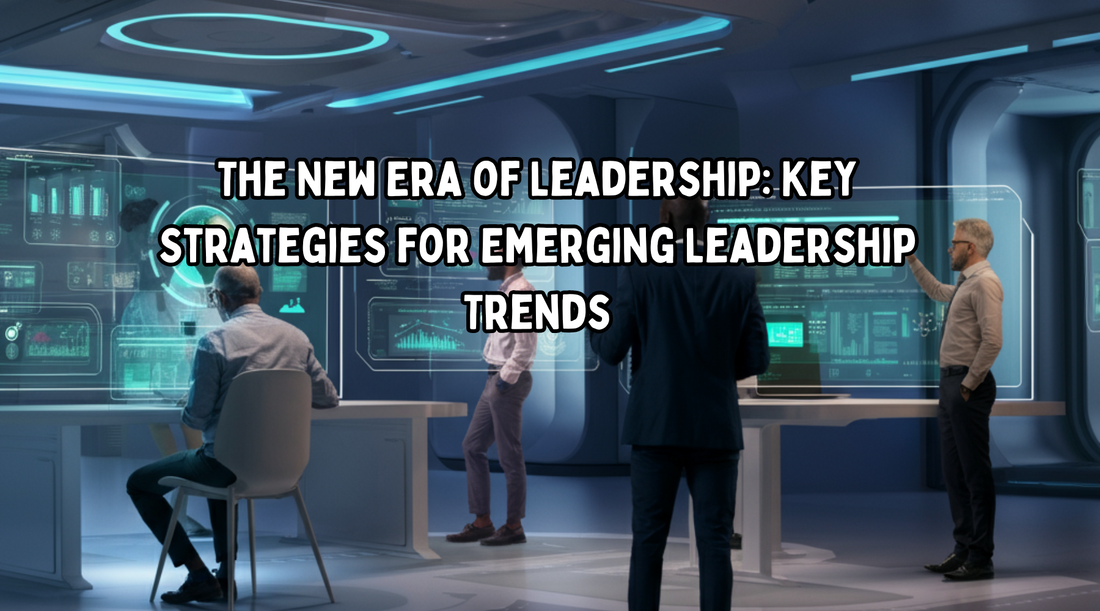
The New Era of Leadership: Key Strategies for Emerging Leadership Trends
Share
Leadership is transforming faster than ever, spurred by global changes, technological advances, and a renewed focus on people. In this pivotal time, those who rise above aren’t just reacting—they’re reimagining what it means to lead. From shaping inclusive work cultures to combining human insight with artificial intelligence and building deep trust, today’s leaders hold the keys to unprecedented impact.
The Great Reinvention of Work Culture: Modern Leadership Strategies
A Workplace Revolution
A new chapter in work has begun. The boundaries between office and home are fading, and flexibility is no longer optional—it's expected. The “Great Reinvention of Work Culture” isn’t just about remote or hybrid schedules. It demands a mindset of openness, experimentation, and continuous growth.
Modern leaders must actively create environments where connection, creativity, and productivity bloom—whether your team is remote, hybrid, or on-site. That means rethinking everything: how teams collaborate, celebrate wins, resolve conflict, and pursue growth.
Practical Steps for Leaders:
- Redefine Productivity Structures
Results matter more than hours. Define clear outcomes, set measurable KPIs, reward achievements often, and eliminate unnecessary bureaucracy. This results-oriented approach to leadership motivates teams to perform at their best.
- Prioritize Employee Well-being Programs
Champion well-being through wellness check-ins, employee assistance programs, and flexible hours. Leaders who prioritize employee health create cultures of loyalty and energy.
- Adopt Digital Collaboration Tools & Human-Centric Leadership
Integrated AI-driven project boards, group chat apps, and collaboration suites streamline team efforts. But the human touch matters—maintain space for rituals, milestone celebrations, and genuine feedback.
- Empower Team Autonomy for Innovation
Let your people own their work, fostering trust. Provide frameworks and regular feedback, but give room to innovate and experiment.

Success in Action: Organizational Examples
Remote-first companies like GitLab, Zapier, and Buffer set the standard for distributed team success. Their living handbooks, transparent communication, and feedback-rich routines have become blueprints for results-driven leadership.
Leaders in results-only work environments (ROWEs) see innovation soar. When clarity and trust are high, teams in any sector work as one vibrant ecosystem, seamlessly brainstorming and celebrating together.
Imagine a team, connected across five cities, using shared docs and digital mind maps to collaborate, adapt, and win together. That’s leadership redefined in the modern era.
Promoting Parallel Intelligence: Leadership and Artificial Intelligence Working Together
Collaboration Fuels Innovation
In 2025 and beyond, the best leaders embrace Parallel Intelligence—the synergy between human intuition and the analytical power of AI. Forward-thinking leaders use these tools to enhance decision-making, streamline operations, and unleash new waves of creativity.
The Importance of Parallel Intelligence in Leadership
Utilize vast data streams to reveal invisible patterns, and blend them with empathy and experience for smart decisions. Harnessing AI as a leadership trend not only boosts productivity but also fosters innovation and resilience.
Steps to Foster Parallel Intelligence:
- Upskill Teams in AI and Data Literacy
Provide training and encourage exploration of digital tools. Employees who understand AI use it to amplify strengths and drive results.
- Facilitate Data-Driven Team Decision-Making
Turn insights from dashboards into bold strategies with regular team huddles. Data opens doors; the team decides which to walk through.
- Create Cross-Functional Innovation Hubs
Bring together diverse talents—like marketers, engineers, and strategists—to fuel creativity and solve complex challenges.
- Balance Analytics with Ethical Leadership
Use technology for insight, but never disregard intuition and ethical considerations. Empower your leaders to question, innovate, and guide with hearth
How to Develop AI Skills in Your Organization
Real-World Example
Fashion retailer Zara combines AI for demand forecasting with expert buyers making final calls. Small businesses are leveraging automation—like chatbots and content recommendation systems—while keeping personal service at their core. The right combination strengthens both decisions and customer experience.
Cultivating Trust as a Conduit for Change: Building High-Trust Leadership Teams
The Foundation of Exceptional Leadership
Trust is the foundation of high-performing, resilient teams. Leaders who cultivate trust inspire open communication, commitment, and bold action, even in changing times. Without trust, innovation halts and teams lose momentum.
How to Build Trust in Leadership:
- Demonstrate Vulnerability as a Leader
Share lessons from your failures and be open about uncertainties. Vulnerable leadership encourages honesty, creative risk-taking, and a culture of growth.
- Practice Accountability and Transparency
Honor commitments, take feedback seriously, and respond transparently to setbacks. Accountability earns respect and inspires others to follow suit.
- Champion Diversity, Equity, and Inclusion (DEI)
Invite ideas from all corners, establish regular listening sessions, and spotlight diverse contributions. Inclusive leadership leads to smarter, more innovative teams.
- Focus on Consistent, Clear Communication
Communicate early, share updates frequently, and create forums for two-way feedback. Proactive leadership removes uncertainty and builds unity.
Read more on our trust-building frameworks

Turning Trust into Tangible Results
Patagonia stands out for leadership built on transparency and shared core values—from sustainability to employee well-being. This translates to team pride and customer loyalty. But the same principles apply to teams of any size: celebrate successes, act on input, and lead authentically to nurture trust every day.
True leadership is serving those in your charge, encouraging them to reach heights they never imagined.
Wrapping It Up: Your Leadership Action Plan for 2025
Leadership success today means adaptability, authenticity, and the courage to evolve. The rise of hybrid work, AI integration, and renewed focus on trust presents challenges—and massive opportunities—for growth.
Recap your action plan:
- Redesign your environment for innovation and employee well-being.
- Use leadership technology as a springboard, not a replacement.
- Prioritize trust and listening for true engagement.
Remember, each step—no matter how small—propels your organization toward peak performance. The future of leadership is built on daily choices, bold experiments, and unshakeable purpose.
Subscribe for more leadership insights and trend updates
Leadership FAQ: Emerging Trends, Strategies & Best Practices
What are the top leadership trends in 2025?
The leading trends are the reinvention of work culture, integration of parallel intelligence (combining human leadership with AI), and a heightened focus on trust, inclusion, and employee well-being. Leaders who embrace these shifts gain a distinct advantage.
What are key leadership strategies for hybrid and remote teams?
Set clear goals, prioritize outcome-driven performance, and encourage ongoing feedback. Use digital tools for seamless connection, commit to well-being practices, and celebrate achievements to keep teams engaged wherever they work.
How can leaders drive innovation and adapt to change?
Create a safe environment for experimentation and failure. Encourage cross-functional teams, invest in continual learning, and leverage AI to gather insights that drive breakthrough ideas.
How does building trust help leaders succeed?
Trust unlocks psychological safety, higher engagement, and loyalty. Leaders who communicate transparently, practice inclusivity, and demonstrate vulnerability build stronger, more adaptable teams.
How does parallel intelligence shape the future of leadership?
By blending human intuition, ethics, and creativity with the analytical power of AI, leaders make smarter, faster, and more ethical decisions—future-proofing their organizations for long-term growth.
Why is employee well-being a leadership priority?
Employee well-being reduces burnout, improves retention, and sparks higher productivity. Leaders championing well-being see more resilient teams and better business outcomes.
What are actionable leadership skills to start developing today?
Begin with active listening, gratitude, and honest feedback. Learn about AI tools relevant to your field. Build your team’s psychological safety—these daily actions forge stronger leaders and teams over time.
How do you measure leadership success in modern organizations?
Go beyond revenue—track engagement, retention, and innovation. Use feedback loops, measure trust (via surveys), and celebrate not just results, but behaviors that reflect your organization’s values.
Want to learn more? Explore our full library of leadership resources.
Three Hard Truths About Success Most Men Avoid (And How to Finally Face Them)
“Lead Boldly. Grow Continuously.”
